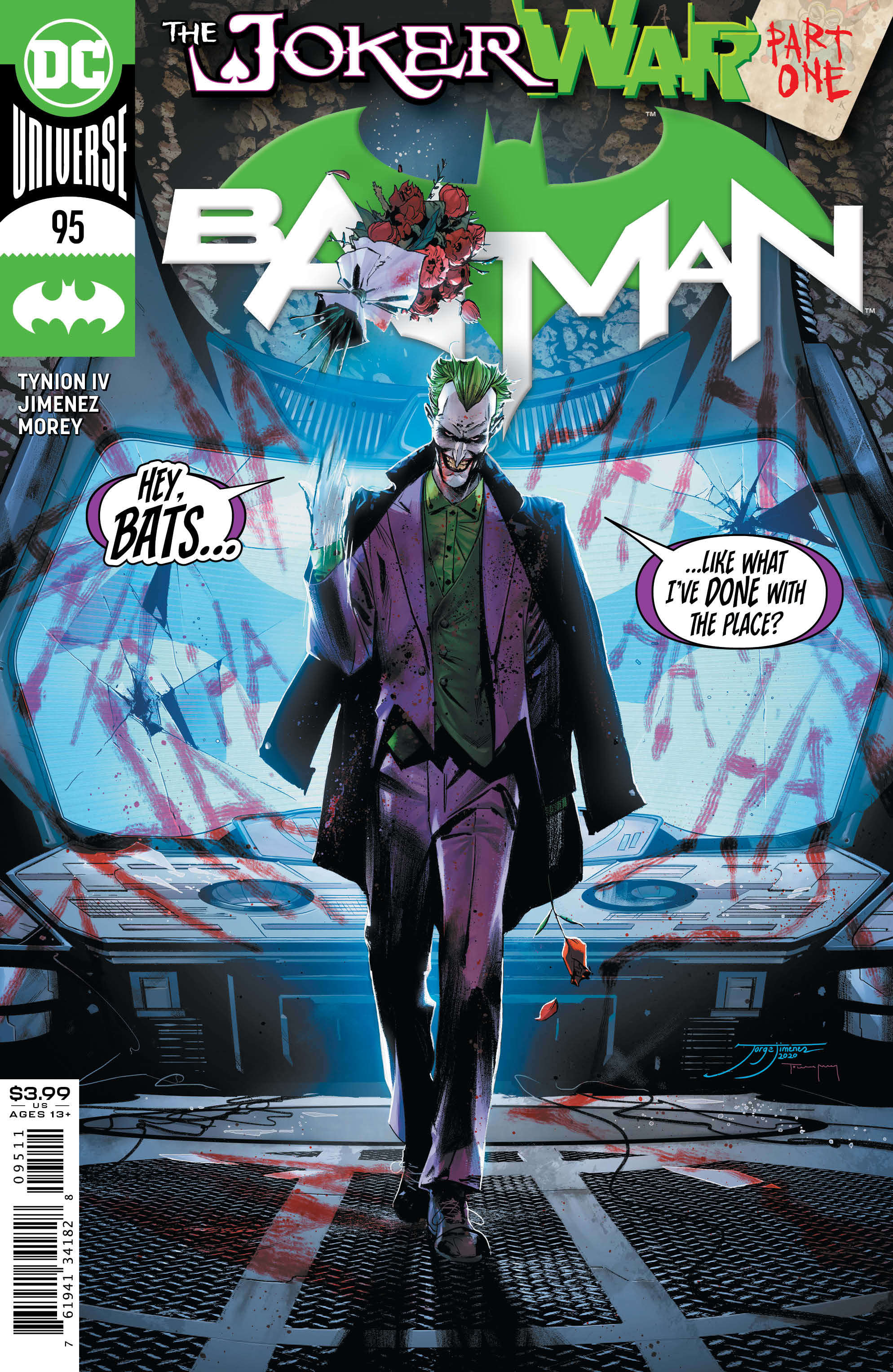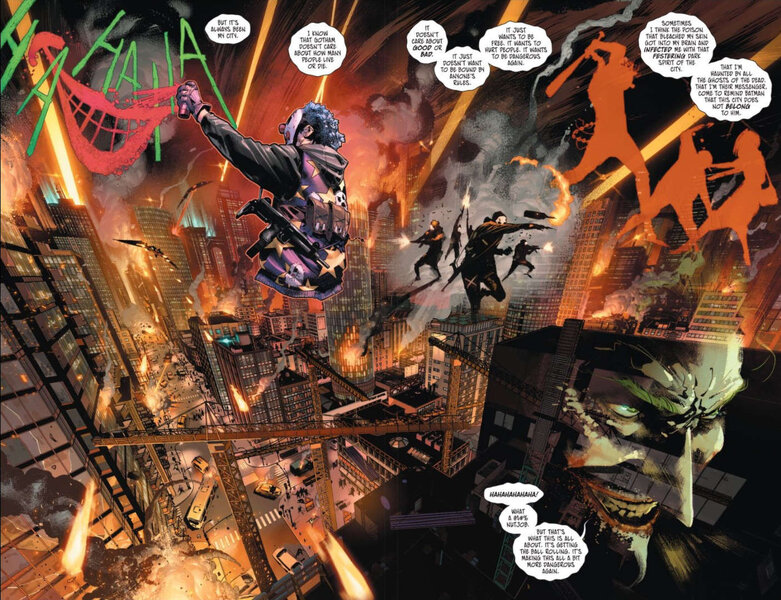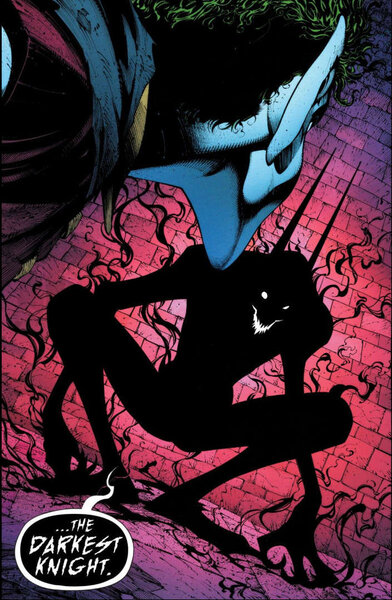Create a free profile to get unlimited access to exclusive videos, sweepstakes, and more!
How Joker War and The Batman Who Laughs cured my Joker fatigue

I'm sick of The Joker, but it wasn't always this way.
I was lucky enough to grow up surrounded by Batman media, even before I got into comics. I'm a child of the mid-1980s, which means by the time I hit my first superhero phase, I had Cesar Romero playing The Clown Prince of Crime in reruns, Jack Nicholson on VHS, and Mark Hamill's incredible (and for me, still definitive) version of Mr. J on TV every day after school. It was a great time to be obsessed with Gotham City and its many weird residents, and I was convinced that obsession would never die. Cut to nearly two decades later, and there are days when I'd be happy if Joker went in a file drawer somewhere at DC Comics headquarters and didn't come out again for a solid decade.
What went wrong? Maybe it's that the character has been the object of hyper-focused fandom ever since The Dark Knight was released in 2008, a hyperfocus that culminated in last year's Joker, which I found not only dour and soulless but flat-out boring. Maybe it's the continued reliance on The Killing Joke and its character dynamics as some kind of sacred gospel that prevents certain stories from growing beyond the old formulas. Maybe it's just that I'm tired of seeing the same "one can't exist without the other" philosophy play out over and over again. It's probably a combination of all of the above, but the cause is perhaps less important than the symptom. For quite a while now, I've been in the throes of Joker fatigue, which isn't fun when the dude's still the star of at least two or three marquee stories across various mediums every single year.
The good news, though, is that keeping a character in near-constant rotation for more than eight decades means that if you hate the current version, all you have to do is wait five minutes until a new interpretation comes along. That's true of most major Big Two characters, but lately, it's proven especially true of The Joker, and two major DC Comics stories, in particular, have arrived this year alone that might just be the cure for my Joker fatigue. In terms of story and character, they're wildly different adventures out to achieve wildly different things, but if there's something they share, it's this: an ambition to give Joker fans exactly what they asked for, but not in the way they expected.
**Spoilers ahead for Joker War and Dark Nights: Death Metal.**
The core conceit of Joker War, the event from writer James Tynion IV and artist Jorge Jimenez wrapping up this month in the pages of Batman, is that The Joker has taken everything from Batman, and by extension Bruce Wayne, in an effort to wage a final war against his arch-rival. Through a series of clever traps, Joker has managed to not only cripple Batman's support system, but also literally seized financial control of Wayne Enterprises, and therefore every toy Bruce Wayne has managed to build for himself over the years as Batman. The entire Bat-arsenal, financial and physical resources alike, has been Joker-fied.
I was, as I've previously admitted, fully prepared to loathe this story, or at least yawn at it while I waited for the next Batman arc to come along, but Tynion and Jimenez won me over in the first issue of the tale (Batman #95) with a sense of over-the-top, weird joy that has persisted throughout the story. This could have so easily been another "deep down, we're the same, you and I" story in which The Joker is only really trying to prove to Batman that they're destined to battle each other forever. It could have so easily fallen back on the same tired tropes, even with the blockbuster scale of its storytelling, and coasted on the sheer size of Joker's takeover of Gotham. Instead, it used all that bombast and strangeness and all those wonderful toys to get at something bigger, which was particularly well-articulated in the pages of Batman #99.
On the surface, as a fan of superhero comics in general, this is just a massive, ambitious piece of storytelling that soars beyond the gritty ethos of so many Joker stories and into something bigger and bolder. These are bold, primary colors aiming to do much more than a showdown between two personalities, and we've seen that pay off already as Tynion and Jimenez have given us side characters like Punchline and Clownhunter to grow the mythology surrounding Joker War into something that will have a lasting impact.
Beyond the plot of it all, though, this is The Joker literally telling the reader that he and Batman are not the same. There's a reason the word "War" is in the title of the story; this isn't just another meditation on how similar the characters are, and how they each have a warped view of the world. In taking away all of Batman's toys and giving them to Joker, Tynion didn't just flip the script on the physical battle. He laid bare just how opposed the two characters are, and the result is something that could reshape Gotham City stories for years to come if DC sticks the landing. After all, Joker's argument here isn't just that he's right and Batman's wrong. It's that the entire city disagrees with the fundamental pillars of Batman's war on crime. That's both a compelling and flat-out terrifying idea for a story, and it doesn't hurt that the same story features Joker cruising through Gotham in a stretch Hummer and making his own Batsuit.
Which brings us to the other story curing my Joker fatigue, one that was years in the making and somehow keeps succeeding despite increasingly unhinged rolls of the dice: Dark Nights: Death Metal, and the ongoing saga of The Batman Who Laughs.
If Joker War is "What if Joker got all of Batman's stuff?" then the saga of The Batman Who Laughs, which kicked off with the Dark Nights: Metal event in 2017, is "What if Joker and Batman were the same person?" The character hails from an alternate Earth where Bruce Wayne was exposed to a purified form of Joker toxin hidden in The Joker's heart, which was released when that Earth's version of The Clown Prince of Crime died during a struggle with Batman. The result is a version of Bruce Wayne warped into someone who has all of Batman's intelligence, fighting skill, and efficiency, and all of The Joker's madness and ego. He's the best (and the worst) of both worlds in one demented package.
This idea is, of course, completely ridiculous, and if you're not reading the comics that comprise The Batman Who Laughs' ongoing story you would be forgiven for thinking that this is the natural and most horrendous final evolution of the grimdark trend of Joker storytelling. After all, storytellers have been playing the "We're not so different, you and I" card with these characters for decades, so of course one day someone had to come along and make them the same guy, right?
The Batman Who Laughs works, though, and the reason why he works for me is twofold. First, there's the absolutely bonkers scale of the story he's wrapped up in. This is not just a story about a grim, grinning Batman with spikes over his eyes cackling as he slaughters all the heroes of Gotham City. This is a story about a grim, grinning Batman who rises up from the Dark Multiverse — you know, the Multiverse that's underneath the regular Multiverse, where all the dark stuff comes from — and basically decides he's going to use his superior strategic mind to remake the entire DC Universe in his image. This means a lot of things, but most recently in the pages of Death Metal, it meant replacing his brain with the brain of another alternate Bruce Wayne who was also Dr. Manhattan and using the reality-warping powers of that character to transform himself into yet another character who calls himself "The Darkest Knight."
This is, as the description suggests, absolutely bonkers, even when you account for the fact that Death Metal also contains a Batman who is also Darkseid, a Batman who is also a dinosaur, and a Batman who is also a sentient Batmobile. (No, I am not joking.)
The bombast, and the resulting size of the story surrounding The Batman Who Laughs and his machinations, buys Snyder and Death Metal artist Greg Capullo a lot of goodwill from me because it means that even when the story gets dark, it gets dark in a fun way, without lingering too long on the kind of performative, "grounded" darkness that I've come to resist in my superhero comics. But there's something else at work here too, which brings me to the second and arguably more important reason why The Batman Who Laughs works so well.
Death Metal is billed on its title page as an "Anti-Crisis," and the entire story revolves around Wonder Woman and various other DC heroes and villains working to rebuild the Multiverse after The Batman Who Laughs has remade it in his own grim image. In response, we get The Darkest Night, an even darker evolution of a character who was already "Batman and The Joker in one body." It's a darkening of a darkening of two characters who were separately dark to begin with, and while another story might simply use that as a shallow exercise in grim and gritty posturing, Snyder and Capullo are using it for more.
The Batman Who Laughs and his evolution is not just a grim antagonist meant to play on our need for ever-darker versions of The Joker — he's the entire idea of grim and gritty superhero comics made flesh. Every story where someone decided Superman had to grit his teeth and snap necks, every story where Wonder Woman had to break down in tears, every story where Batman had to admit that he couldn't shake the idea that he and The Joker were just too alike, every severed limb, every gratuitous death, every time someone felt the need to say "comics aren't just for kids anymore" — that's all packed into the Batman Who Laughs' rictus grin. And in Death Metal, Wonder Woman, Batman, and Superman are standing up to fight that.
The Joker will never go away. Comics may one day be beamed into our brains one panel at a time through a chip in our heads, and that dude will still be suiting up and loading his pockets with knives and poisonous flowers. If you're sick of him, that might seem like a horrible thing at times, but the great thing about shared superhero universes is that someone is always coming along to give you a new view, a new reinvention, a new ray of light in an otherwise dark landscape.
It turns out I wasn't sick of The Joker after all. I just needed the right stories to remind me why he can still work, and why he'll probably never stop working.
Joker War concludes with Batman #100 on Oct. 6. Dark Nights: Death Metal continues with issue #4 on Oct. 13.
The views and opinions expressed in this article are the author's, and do not necessarily reflect those of SYFY WIRE, SYFY, or NBCUniversal.




























